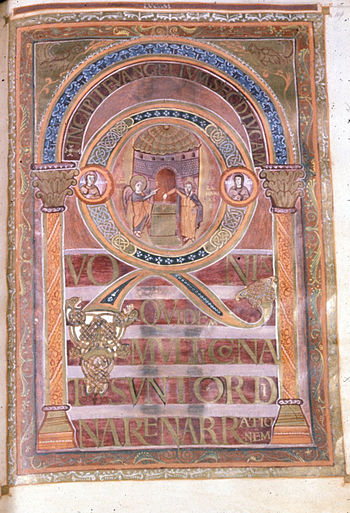God end times judgements as described by the Apostle John
 |
| "Son of man" appears 25 times in Luke, a copy (c. 800) shown here. (Photo credit: Wikipedia) |
Some of John’s descriptions are easy to recognize as symbolic (or metaphorical). For example, when the risen Jesus promises to the Christians in Philadelphia, “If you conquer, I will make you a pillar in the temple of my God” (Rev. 3:12), even interpreters who want to explain the contents of the book of Revelation as literally as possible state that “this is of course a figure of speech.”
Since the Reformation, the importance of a literal interpretation has been recognized and emphasized by evangelical interpreters of Scripture. However, the expression “literal interpretation” or, with the Latin phrase the Reformers used, finding the sensus literalis of Scripture, must be carefully defined. Not every word or expression in the Bible is to be understood “literally” in terms of the normal usage of the word or expression. When Jesus says, “I am the gate for the sheep” (John 10:7), neither the word “gate” nor the word “sheep” is meant to be understood in the normal usage of the words.
In this context, the two words are used with a symbolic, metaphorical, or figurative meaning. If John, who relates Jesus’ words, wanted his readers to understand the words “gate” and “sheep” as symbols for the significance of Jesus who provides access to God’s presence and God’s salvation (“gate”) for God’s people (“sheep”), such a symbolic reading is the intended reading. A “literal” or, rather, “literalist” reading leads in this case to nonsense, in other cases to misinterpretation.
The main question is not how many of the words and expressions of the Bible we can interpret literally, but whether the author’s intended meaning is literal or symbolic (or figurative).
The details of the first four judgments of the seal series indicate that John is not describing new developments: wars of conquest (seal 1) took place in the late first, second, and third centuries, and ever since. The same holds true for international unrest (seal 2), famine and hunger (seal 3), and the effects of warfare (sword), famine, and plagues, all of which kill people (seal 4).
Literal events that resemble the judgments depicted in the seal, trumpet, and bowl judgments are not impossible to imagine—not only because of God’s sovereign power, but also because of humankind’s seemingly endless capacity for devising, producing, and deploying technologies and weapons that affect or have the potential to affect large parts of the globe.
At the same time, John’s concern is not to provide his readers in the first century with a detailed timetable of future events that allows them to establish how close the end is. Even taken literally, many of the judgments described in the three series have been a reality since the first century (and before—for example, during Israel’s exodus from Egypt), in varying degrees and in different regions of the earth. The symbolism of most if not all of the numbers in the Apocalypse suggest that John’s focus is not on historical events for their own sake but on the meaning of God’s judgment both for the world (as a call to repentance) and for the church (as a call to faithful perseverance and courageous witness).
Schnabel, E. J. (2011). 40 Questions about the End Times. (B. L. Merkle, Ed.) (pp. 64–65). Grand Rapids, MI: Kregel Academic & Professional.

